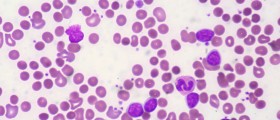
Agranulocytosis
Agranulocytosis is a medical problem which appears when the bone marrow doesn’t produce enough white blood cells. It lowers significantly the number of the white blood cells (under 100cells/mm3), especially the neutrophils. Other white blood cells might also be lowered, including the eosinophils and basophils.
Decreased number of white blood cells affects the immune system and increase the potential risk of illnesses and infections.
Agranulocytosis might be presented with fever, chills, sore throat, mouth ulcers, gum problems, low white blood cells, body weakness and jaundice. Patients often experience different infections, including fungal and urinary infections, bacterial pneumonia and septicemia. Osteoporosis might also be a symptom ofagranulocytosis.
Agranulocytosis might be congenital or acquired. Congenital agranulocytosis is the condition present since the birth, and the acquired agranulocytosis is a condition caused by some medications. Whatever the type of this condition is, illness is treatable. You should consult the doctor in order to find the best possible treatment for your condition.
Risk Factors for Agranulocytosis
There are many identified risk factors that may lead to agranulocytosis. Some of them are: aplastic anemia, autoimmune disorders, chemotherapy, exposure to toxins or radiation, leukemia, myelodysplastic deficiency, serious infections, deficiency of vitamin B12 and genetic predisposition to this medical problem.
Causes of Agranulocytosis
Congenital agranulocytosis is caused by a genetic problem.
Acquired agranulocytosis is the medical condition provoked by: some infections and the use of some medications. Non steroidal anti inflammatory drugs (NSAIDs), cytotoxic medications, gold, antibiotics, anti-epileptics, anti-thyroid medications and mebendazole are known to cause agranulocytosis. Other causes of this condition include: toxins in the blood, different autoimmune or diseases of the white blood cells and aplastic anemia. Bone marrow fibrosis and cancer can also lead to agranulocytosis.
Use of cocaine might be the cause of this condition. Cocaine is often mixed with some animal antihelmintics, such as levamisole, which can cause agranulocytosis.
Diagnosis and Treatment ofAgranulocytosis
The diagnosis is established after some blood test, which determines the number of white blood cells. There might be some additional testing, including the urine and bone marrow testing and a genetic test, to confirm the diagnosis. If the patient is suspected to have an autoimmune disorder, the doctor will ask for anti-neutrophil antibody test.
Possible treatment might include transfusion of leukocytes, G-CSF or GM-CSF stimulating factors. If the condition was caused by some other blood problem or infection, a doctor will prescribe medications to take care of the primary problem.
The best way to deal with the case of seriously low white blood cells is to consult the doctor. He/she will diagnose the condition and prescribe the therapy suitable to that particular patient.

















Your thoughts on this
Loading...